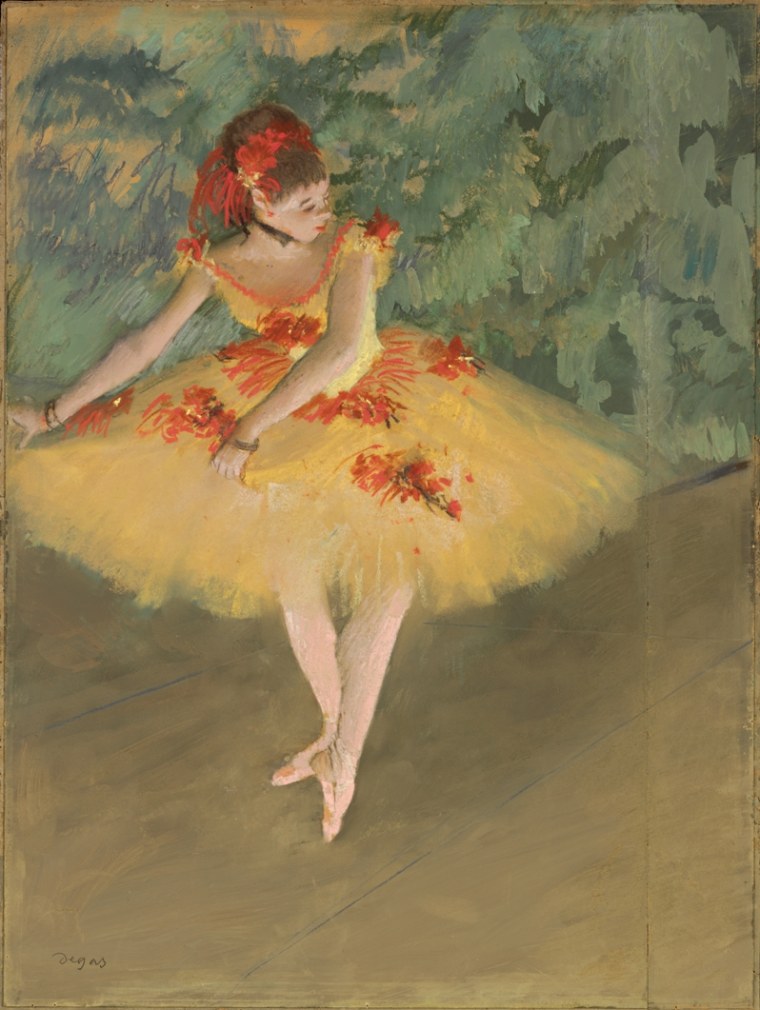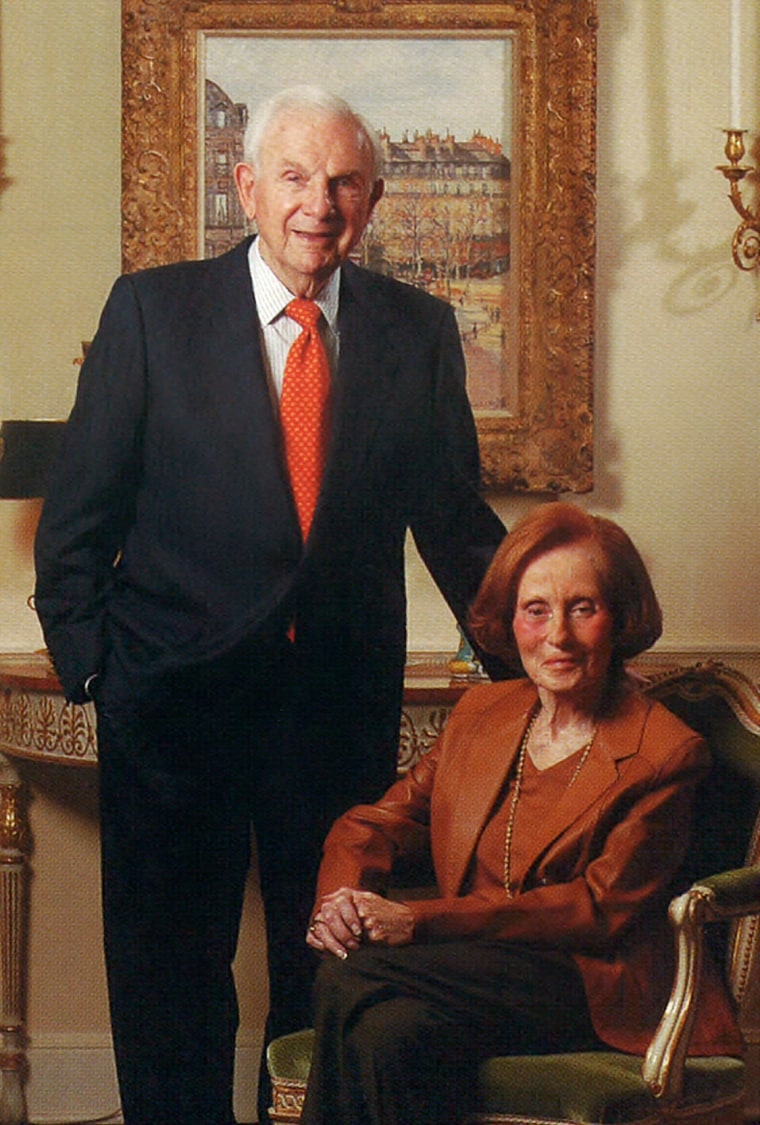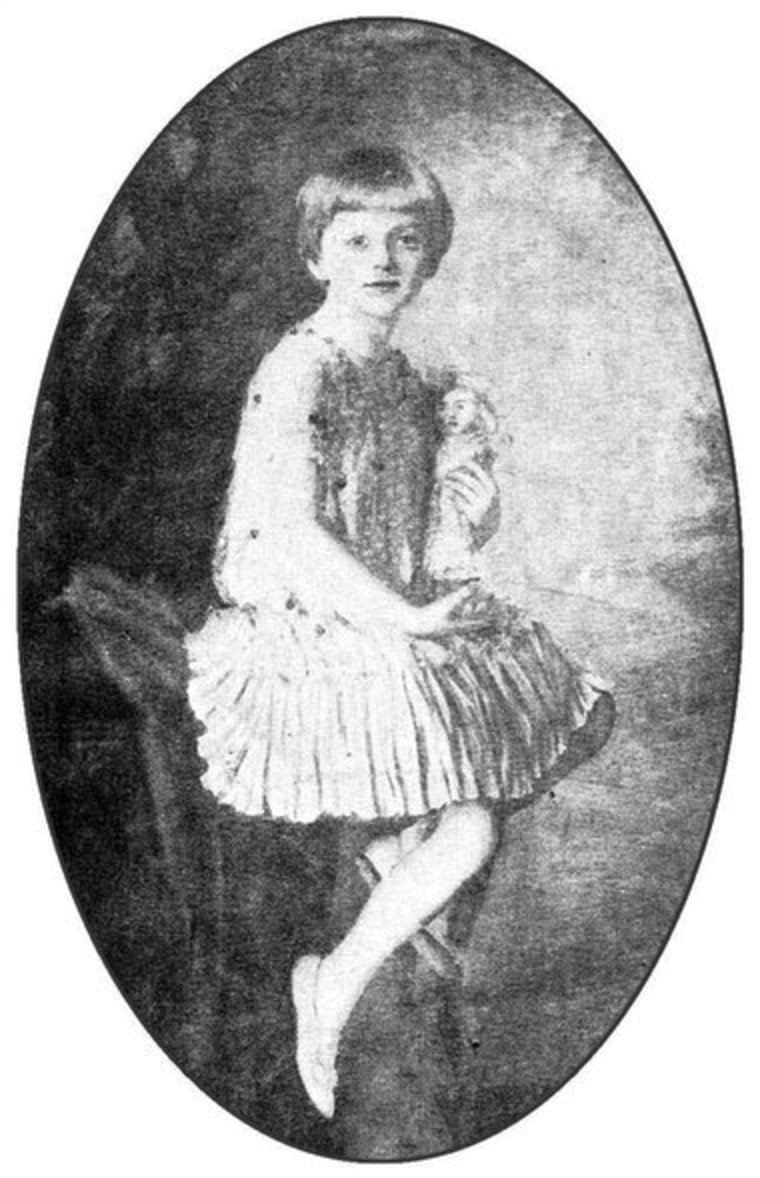
NEW YORK — The mystery itself is a masterpiece. A $10 million painting by Degas — a simple figure of a ballerina in a yellow and red tutu pointing her toe – vanished from the New York City apartments of reclusive heiress Huguette Clark, and wound up, innocently enough, on the living room wall of Henry Bloch, a Kansas art collector better known as the "H" in the tax company H&R Block. How it got there is a multi-layered tale involving one of the more colorful transactions in the history of high-end art.
For readers who have been following the Clark mystery story on msnbc.com, this episode provides a new piece of evidence that could be important in the legal battle over her $400 million estate. Now we know that her longtime physician, as part of a settlement over the painting, signed a statement swearing to her competency, describing his then-102-year-old patient as "mentally and physically alert." This was in 2008, or three years after she signed a will cutting her family out of any inheritance and planning an art museum in her California home.
The circumstances in which the Degas ballerina disappeared from Clark’s Fifth Avenue apartments in the early 1990s remain unclear, but for the first time the story can be told of how it ended up in Bloch’s living room, above the sofa, between a Seurat and a Toulouse-Lautrec. And how Bloch was allowed to keep the painting even after the FBI came calling.
When it was discovered in 2005 that Bloch and his wife had purchased a painting with a tainted past, a quiet dispute over its ownership erupted. It had been taken from Clark's apartment, but it also had been bought in good faith by the Blochs.
Valuing her privacy more than her possessions, Clark had told her attorney and the FBI in 1992 not to pursue the loss of the painting. She didn't list it on the international registry of stolen art. As a result, in a high-stakes legal version of the children's rhyme "finder's keepers, loser's weepers," she may have lost her claim to the painting. The Blochs' attorney argued that it now belonged to them.
After well-mannered wrangling, Clark and Bloch reached a deal. Clark agreed to donate the painting to an art museum in Kansas City, Mo., the Nelson-Atkins Museum of Art, where Bloch had been a longtime trustee, chairman and benefactor, and where he and his wife had promised to donate all their art when they died. As part of the agreement, the heiress, not America's Tax Man, got the income tax deduction for the gift.

The handoff
To seal the deal, the ballerina needed to change hands. In October 2008, on a clear but crisp Monday at the Bloch home in Mission Hills, Kansas, a museum representative handed the ballerina in the gilded frame to Clark's attorney, who handed it back to the museum, and back onto the Blochs' wall it went. The museum had agreed to lend the painting back to the Blochs, and they will have it as long as they live, renewing the loan every year. Then it will go back to its owner, the Kansas City museum, with the rest of the Bloch collection of Impressionist masterpieces.
The parties signed a confidentiality agreement, keeping the whole business secret even from the staff of the museum. Only three of its 21 trustees were told.
When the museum announced in 2010 the promise by the Blochs to donate 30 Impressionist masterpieces at their death, the Degas dancer was featured in The Kansas City Star newspaper, although the museum at that point had already owned the painting for two years.
Last month, when asked about the ballerina, the museum public relations staff said emphatically that it was not owned by the museum.
'Stunning'
"This is a remarkably beautiful work by Degas. Everything about this work is stunning," wrote Joachim Pissarro, curator of the department of painting and sculpture at the Museum of Modern Art in New York City, describing the gentle figure of a dancer in bold yellow and orange, set against brown floorboards and a green backdrop of foliage on a stage.
Edgar Degas, the reluctant Impressionist who preferred to be known as a Realist, painted the ballerina in France in 1879-1880, as his eyesight was failing. It's a seemingly simple work, 19 by 14½ inches, with pastel and gouache applied to paper. It's known as "Dancer Making Points," or in French, "Danseuse Faisant des Pointes."
The ballerina was sold at a gallery in Paris in 1927, then passed to the French collector Georges Lévy, who brought his collection to America in 1939-1940 to escape the Nazis. Huguette Clark or her mother bought it sometime before 1955.
The youngest daughter of the former U.S. Sen. William Andrews Clark, known as one of the Copper Kings of Montana, Huguette Marcelle Clark was born in Paris in 1906. In his day, her father could have bought up all the works of all the Impressionists with one week's income from his mines, but he mostly preferred older paintings.

In 1991, at age 84, Huguette Clark moved from her 42-room apartments on New York's Fifth Avenue, and would live the remaining 20 years of her life in hospital rooms. She left behind a Monet, a Renoir and many other treasures.
Documents and interviews show that it didn't take long for one treasure to go missing.
In 1992 or early 1993, her attorney, Donald Wallace, learned that the Degas ballerina was lost. There was talk that a member of the building staff had taken it, or that doormen had seen it next to a trash bin in the building. In any case, the ballerina was gone. Wallace informed his client, whom he never met face to face in 20 years of representation. Clark discouraged him from pursuing the matter, maintaining her longstanding policy of not doing anything that would generate publicity, even if it cost her millions.
But her attorney, or the building manager, called the FBI. Wallace explained that Clark saw no visitors, but the FBI agents barged into her hospital room anyway. She discouraged them from investigating. She didn't file an insurance claim. She didn't register the painting with the Art Loss Register, a company founded in 1991 that was becoming the de facto place to check for stolen art.
'Seemingly from a good family'
Later in 1993, a well-dressed man walked into the Peter Findlay Gallery, about a 15-minute stroll down Fifth Avenue from Clark's apartment.
"Many years ago," Findlay told msnbc.com in an email, "I had a gallery on Madison Avenue and sold good things of a European taste, particularly Impressionist works such as Degas, etc. Naturally people would stop in to look and to chat. Among them was a European gentleman, seemingly from a good family, who visited New York from time to time and would occasionally visit the gallery.
"At some point he told me that he had inherited a work by Degas that had been in his family for many years and asked if I would help him sell it. Eventually the work was brought to the gallery. It had the aura of a work that had been in a family for a long time."

At this time, Henry and Marion Bloch were shopping in New York for paintings. Henry and his brother, Richard, had founded a tax accounting firm in Kansas City in 1955, calling it H&R Block, changing the spelling slightly from their last name.They built a nationwide business after the Internal Revenue Service stopped helping people fill out their tax returns. Henry Bloch, 89 today, had been a navigator on American B-17 bombers during World War II, and by all accounts is a hard-working, humble man. He and Marion, who have been married for 60 years, built a collection of Impressionists, eventually acquiring works by Renoir, Monet, van Gogh.
To buy one of Degas' famous series of dance paintings, for an undisclosed price, the Blochs sold a lesser Degas, of three dancers. Bloch later told The Kansas City Times, "This was so much finer."
Findlay said he did everything he could to confirm the provenance of the painting, checking with the Art Loss Register. "I was shocked when I heard from the FBI that the Degas was stolen."
Christopher A. Marinello, executive director and general counsel for the Art Loss Register in London, said in an interview that buyers should do their own checks on the authenticity and good title of art. "It costs less than $100 to check the ownership of a $5 million painting. People will buy a used car and they'll take it around the corner and put it up on a lift and check it out, and they'll get a Carfax report. They'll spend millions on art, and do nothing."
The Blochs mostly kept their collection at home, but in the summer of 2007, the Degas held center stage at the Nelson-Atkins when the Marion and Henry Bloch Collection highlighted the opening of the Bloch Building, named for its benefactors. The exhibition was sponsored by the H&R Block Foundation. The museum displayed a close-up of the Degas ballerina as a signature image of the collection, and notecards with the image are still for sale today in the museum gift shop.
Two years earlier, the museum and the Blochs had learned from the FBI that the Degas ballerina might belong to someone else.
In 2005 an auction house in New York had noticed that a Degas owned by Clark (known then as "La Faisant des Pointes" or "Making Points") was apparently the same one sold to Henry Bloch.
"I believe I may have been first contacted in late 2005," Henry Bloch said in a written answer to questions from msnbc.com, "by the FBI, who indicated that they were conducting an art investigation and wanted to confirm their information that we had purchased the Degas." The FBI, Bloch said, "did not give any indication that it had been stolen and gave us assurances there was nothing to worry about. I nevertheless shared the inquiry with my attorney at the time who discussed it with the Director of the Nelson-Atkins. I do not believe I was contacted again by them until late 2007."
In late 2007, the Blochs received a subpoena from the U.S. Attorney's Office, asking them to turn the painting over to the federal court during the investigation. A round of meetings began with the FBI, the U.S. Attorney, and the attorney for Clark.
Nobody wanted a lawsuit
The attorney for the Blochs took the position that the painting was theirs, fair and square.
Attorney John R. Phillips represented both the Blochs and the Nelson-Atkins. "The law is clear that the Blochs were – and the Nelson-Atkins Museum now is – the rightful owner of the work," he said in written answers to msnbc.com.
The two sides couldn't agree whether the painting had actually been stolen. Clark's attorney argued that the FBI file clearly showed that the painting had been reported as stolen. The attorney for the Blochs argued that the FBI never concluded for sure whether the painting had been given away, lost or stolen.

Even if it had been stolen, the Bloch claim cited legal cases requiring diligence by the loser of property to try to recover it. The idea is that unreasonable and inexcusable delay puts an unfair burden on the later possessor of the property. The doctrine is called laches (from the Old French word for "slack"). Failing to exercise your rights can cause you to forfeit them. One of the well-known cases involved the artist Georgia O'Keefe, who never reported to police the loss of a painting. Moreover, a Kansas law (and the Degas ballerina was then in Kansas), called a statute of repose, sets a 10-year limit on a lawsuit to recover an item.
Most people in Clark's position would have fought for their property, and Clark, a painter herself, did want her Degas to be returned. Documents show that her attorney, Wallace "Wally" Bock, advised her that she had the option to sue for the painting or its value. But she abhorred lawsuits, and a 102-year-old recluse was never going to sit for a deposition.
The main goals for the Blochs were to keep possession of the painting during their lifetimes, and to make sure it then went to the Kansas City museum. Their attorney made a proposal: If Clark were to donate the painting to the Nelson-Atkins, the Blochs would give up ownership immediately, and cede possession after they died.
Before the handoff, Sotheby's appraised the painting at $10 million. Clark would be able to claim that amount as a charitable deduction on her income tax return.
On Oct. 7, 2008, in her recognizable handwriting, now a bit shaky, 102-year-old Huguette Clark signed a deed giving her ballerina to the Nelson-Atkins Museum. (Read the document in PDF form.)
'Mentally and physically alert'
There was one more hitch, which could play a large role in the court fight now beginning over Huguette Clark's $400 million estate. The museum would not accept the gift from the centenarian, particularly one whom they couldn't meet, unless Clark provided a doctor's statement affirming she was competent to make the gift.
On Oct. 10, 2008, Clark's longtime physician signed a sworn statement. The affidavit by internist Dr. Henry S. Singman began by explaining that he was semi-retired, and had only the one patient.
"I am and have been personal physician to Madame Clark, who resides at 907 Fifth Avenue, New York, New York, since 1991. As such, and because of her advanced age, I visit her on an almost daily basis."
He said he had seen her just the day before. "At that time, and on all previous visits, I found her, although slightly hard of hearing, to be mentally and physically alert, able to read and comprehend written and printed material as well as verbal communications, competent to understand and execute documents and to sign her name thereto without assistance." (Read the document in PDF form.)
Huguette Clark died at age 104 in May 2011, having signed two wills in 2005, when she was 98. The first will left nearly everything to her family, the great-grandchildren from her father's first marriage. The second will, signed just six weeks later, was more detailed, excluding her family entirely, making plans for an art museum in her Santa Barbara oceanfront home, and leaving about $36 million to her nurse ($27 million after taxes), a $40 million Monet to the Corcoran Gallery of Art in Washington, D.C., with substantial gifts to a godchild, her doctor, her attorney, her accountant and others.
If Clark was mentally competent in 2008 to make a stunning act of generosity, ceding any claim to a $10 million painting that had been taken from her, then it may be harder for her family to prove that she was incompetent in 2005 to sign that second will.
The attorney for the family, John R. Morken, said he would first question Dr. Singman's independence. The doctor is not only a beneficiary in that second will, named to receive $100,000, but also received gifts from Clark of $60,000 to $115,000 a year in her last years, over and above his payment for medical services, similar to the large gifts she gave others in her tight circle. "Obviously he wouldn't say that she lacked capacity, or else these gifts would be invalid," Morken said yesterday. "All I can say is, I look forward to his deposition."
Singman also signed a similar statement of her competency in 1995, as required by one of her banks for a financial transaction, long before she signed a will. He declined to comment this week.
The family has made a second argument, contending that Clark was unduly influenced by the nurse, attorney and accountant to sign the second will. The attorney and accountant have said that it was drafted according to her explicit instructions.
"In this transaction," said Morken, the family attorney, "I would question what was told to her, whether she knew what she was giving up."
The temporary executor of her estate, the public administrator of the city of New York, has challenged certain gifts paid from Clark's accounts, including a $5 million gift to her nurse, but has not challenged the gift of the Degas. That silence could indicate that the executor found the gift to be well documented. The attorney for the public administrator, Peter Schram, declined to comment.
'Strict confidentiality'
On Oct. 27, 2008, the painting changed hands outside the Bloch home in Mission Hills, a suburb of Kansas City. The museum's director, Marc F. Wilson, now retired, was present for the round-robin hand-off, as was Phillips, the attorney for the Blochs and the museum. Clark was represented by her attorney, Bock, and accountant, Irving Kamsler. The 128-year-old painting was walked out to the car, handed around gently like a newborn baby, and back inside it went.
The U.S. Attorney's Office withdrew its subpoena. No one was charged with taking the painting. The FBI said this month that the case remains open.

The exchange was kept secret. The Blochs and Clark signed a confidentiality agreement. The museum told only three of its 21 trustees, the three who serve as an executive committee. Even the museum's curators of European paintings were not told. No entry for the painting was created in the museum's records.
"We have consistently worked to honor our donors’ wishes for privacy and to respect the strict confidentiality requested by Ms. Clark at the time of the gift to the museum," explained the new director of the Nelson-Atkins, Julián Zugazagoitia, who joined the museum in 2010, in written answers to msnbc.com.
Was the museum's decision to lend the painting back to the Blochs, secretly, the ethical choice? The Nelson-Atkins is open free to the public, which would be able to enjoy the Degas today, if the museum staff knew that it owned the painting.
If the Blochs had fought for ownership and won, the painting wouldn't have come to the museum any sooner, staying at the Bloch home as part of their collection until their deaths. If they had fought and lost, the painting would probably have remained hidden away in the Clark apartment until after she died in May 2011, and would be headed for her proposed art museum in California if her last will is upheld.
"Despite a highly unusual course of events," museum direcdtor Zugazagoitia wrote, "and thanks to Ms. Clark's role as an additional benefactor to the museum, Mr. Bloch has been steadfast in ensuring that the work ends up in the museum's collection for the benefit of the public. We are extremely grateful for the generosity of both the Blochs and Ms. Clark."
A memento
Before the transaction was concluded, Huguette Clark made two requests.
Though Clark gave the painting without restriction to the Nelson-Atkins, in a side letter she asked that her beloved Corcoran Gallery, where most of her father's art is on display, should be allowed to borrow the painting up to three times in 25 years. If it were shown there, she would receive credit by name. But in Kansas City, the painting is listed as an anonymous gift.
After the Degas was deeded to the museum, the heiress also asked for, and received, a full-size color photograph of her ballerina.
---
Reporter Bill Dedman is writing a nonfiction book about the Clark family. If you have information, you can reach him at bill.dedman@msnbc.com.
Here's a video companion piece from KSHB in Kansas City:
Previous stories in the Huguette Clark mystery series on msnbc.com:
Archive of all stories, photos and videos.
Photo narrative, "The Clarks: An American story of wealth, scandal and mystery," Feb. 26, 2010.
Printable version of the photo narrative, Feb. 26, 2010.
Clark family notes and sources, Feb. 26, 2010.
Investigative report, part one, "At 104, the mysterious heiress Huguette Clark is alone now: Relatives are kept away. Only her accountant and attorney visit. Who protects HuguetteClark, with 3 empty homes and no heirs?" Aug. 19, 2010.
Investigative report, part two, "Who is watching Huguette Clark's millions? Reclusive heiress's assets are sold by two advisers, one an accountant with a felony conviction. Another elderly client signed over his property to the same accountant and attorney," Aug. 20, 2010.
"Criminal probe begins into the finances of reclusive heiress Huguette Clark: Manhattan DA's Elder Abuse Unit is on the case. The same unit prosecuted the Brooke Astor case; Clark has about four times the wealth," Aug. 24, 2010.
"Report sparks welfare check on heiress Huguette Clark," Aug. 25, 2010.
"Generosity of an heiress: four homes for a nurse, gifts for attorney's family," Sept. 1, 2010.
"Huguette Clark, the reclusive heiress, has signed a will, attorney says," Sept. 2, 2010.
"Family of copper heiress asks court to protect her from attorney, accountant," Sept. 3, 2010.
"Attorney for 104-year-old heiress defends his handling of her finances," Sept. 7, 2010.
"Judge leaves pair under investigation in control of heiress Huguette Clark's fortune," Sept. 9, 2010.
"Huguette Clark, the reclusive copper heiress, dies at 104," May 24, 2011.
"Family excluded from Huguette Clark burial," May 26, 2011.
"Heiress Huguette Clark's will leaves $1 million to advisers," June 22, 2011.
"The 1 percent of the 1 percent: How Huguette Clark's millions were spent," Nov. 19, 2011.
"A $400 miillion twist: Huguette Clark signed two wills, one to her family," Nov. 28, 2011.
"Tax fraud alleged in estate of heiress Huguette Clark; accountant resigns," Dec. 21, 2011.
"Nurse, in line to inherit millions, battles family of heiress Huguette Clark," Dec. 22, 2011.
"Judge bounces attorney and accountant from estate of heiress Huguette Clark," Dec. 23, 2011.
"Book coming on reclusive heiress Huguette Clark and her family," Feb. 3, 2012.
"You can move into heiress Huguette Clark's building, for $25 million," Feb. 6, 2012.
"Family of heiress Huguette Clark claims fraud by nurse, attorney, accountant," Feb. 15, 2012.
"Heiress Huguette Clark's apartments hit the market, listed at $55 million," March 9, 2012.
"The jewels of reclusive heiress Huguette Clark go on auction," March 13, 2012.